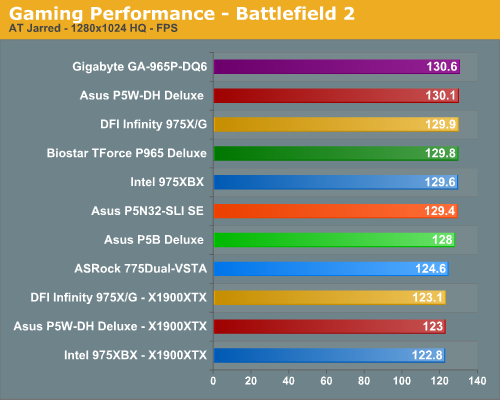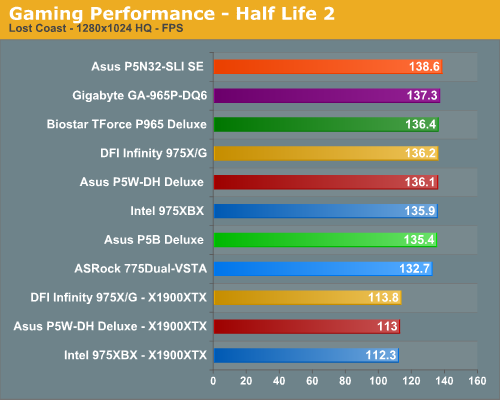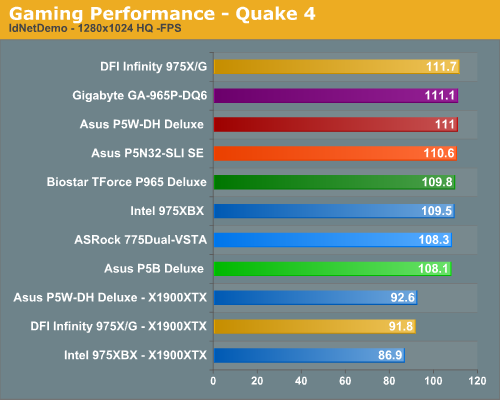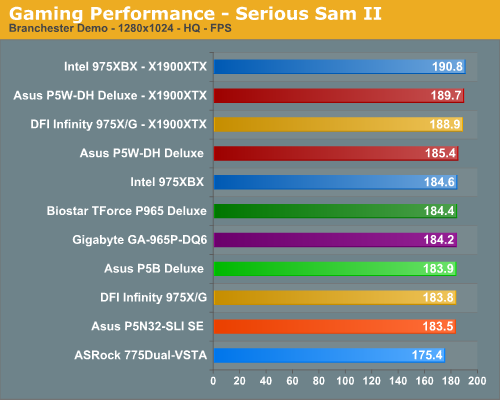Conroe Buying Guide: Feeding the Monster
by Gary Key & Wesley Fink on July 19, 2006 6:20 AM EST- Posted in
- Motherboards
Standard Gaming Performance
We tested with a small group of games due to time constraints, but we picked games based on a variety of game engines to give a quick indication of the boards' performance. Additional testing will be done in our full board reviews but for this roundup we are using Serious Sam 2, Half Life 2: Lost Coast, F.E.A.R, Quake 4, and Battlefield 2. All boards were tested with the EVGA 7900GTX using NVIDIA 91.31 WHQL drivers. The Intel 975X boards were also tested with a single ATI X1900XTX card with the Catalyst 6.6 driver.





The two most performance oriented boards in our roundup are the ASUS P5W-DH and Gigabyte GA-965P-DQ6 boards, and they complete our gaming benchmarks with scores at or near the top of each game category. The most consistent board in the roundup is the Biostar TForce P965 Deluxe that stayed the course throughout testing by remaining in the middle sector of the group. Although the Biostar board did not finish first, it also did not have swings where it was at the top of one benchmark and near the bottom on another one. The ASRock board finished last among the 7900GTX boards four times and second to last on the Quake 4 test where it had its best showing. Overall, the scores generated by this group of boards are so close that you would be hard pressed to actually see or feel the difference in real game play.
The ATI X1900XTX cards finished significantly behind the NVIDIA cards in Half Life 2: Lost Coast where they generally score even or ahead of NVIDIA depending upon game settings. While their performance in the DOOM 3 engine games are normally several percentage points behind the NVIDIA based cards until recently, the difference in our Quake 4 test is also perplexing with the current 6.6 driver release. We ran our ATI X1900XTX in the ASUS P5N32-SLI board and the percentage differences between the GPUs were the same that we see on the AMD S939 or AM2 platforms. It appears to us at this time there is an ATI driver bug with the current Intel chipsets and Core 2 Duo, or perhaps a lack of optimization.
We tested with a small group of games due to time constraints, but we picked games based on a variety of game engines to give a quick indication of the boards' performance. Additional testing will be done in our full board reviews but for this roundup we are using Serious Sam 2, Half Life 2: Lost Coast, F.E.A.R, Quake 4, and Battlefield 2. All boards were tested with the EVGA 7900GTX using NVIDIA 91.31 WHQL drivers. The Intel 975X boards were also tested with a single ATI X1900XTX card with the Catalyst 6.6 driver.





The two most performance oriented boards in our roundup are the ASUS P5W-DH and Gigabyte GA-965P-DQ6 boards, and they complete our gaming benchmarks with scores at or near the top of each game category. The most consistent board in the roundup is the Biostar TForce P965 Deluxe that stayed the course throughout testing by remaining in the middle sector of the group. Although the Biostar board did not finish first, it also did not have swings where it was at the top of one benchmark and near the bottom on another one. The ASRock board finished last among the 7900GTX boards four times and second to last on the Quake 4 test where it had its best showing. Overall, the scores generated by this group of boards are so close that you would be hard pressed to actually see or feel the difference in real game play.
The ATI X1900XTX cards finished significantly behind the NVIDIA cards in Half Life 2: Lost Coast where they generally score even or ahead of NVIDIA depending upon game settings. While their performance in the DOOM 3 engine games are normally several percentage points behind the NVIDIA based cards until recently, the difference in our Quake 4 test is also perplexing with the current 6.6 driver release. We ran our ATI X1900XTX in the ASUS P5N32-SLI board and the percentage differences between the GPUs were the same that we see on the AMD S939 or AM2 platforms. It appears to us at this time there is an ATI driver bug with the current Intel chipsets and Core 2 Duo, or perhaps a lack of optimization.










123 Comments
View All Comments
Beaner - Wednesday, July 19, 2006 - link
Very well-written article guys!Thanks for taking the time to enlighten us all.
Just wanted to point out that the Mushkin Redline sticks can be had right now for $355 AR. At that price, I may just have to grab 'em myself!
ChronoReverse - Wednesday, July 19, 2006 - link
It was pretty much shown that the effect of using memory dividers for Athlon64's was rather minimal while most dividers were more adverse for Netburst.How large of an effect does using memory dividers have on the Conroe?
Wesley Fink - Wednesday, July 19, 2006 - link
The effect of memory dividers is much smaller on Conroe than we saw on Netburst. In fact memory dividers on Conroe behave more like AM2 - probably the result of the "apparent" reduction in latency with the intelligent look-ahead in memory. Core 2 Duo is not Hyper-Transport, so 1:1 (533) tis still theoretically the highest performing setting, but we were hard pressed to find any measurable advantage of 1:1 in most situations.We had tested a number of high-performance dimms on Conroe before we wrote the Buyers Guide, but there just wasn't the time - or room - to include full memory performance data in the Guide. We do have memory reviews in process that will provide specifics to your questions.
We can summarize what we have learned about memory on Conroe so far. DDR2-667 is quite a bit higher in real perfomance than DDR2-400 or DDR2-533 (1:1). We would consider DDR2 to be the minimum memory that should be used with Conroe. Going up from DDR2-667 we found the following - from fastest to DDR2-667. DDR2-1067 4-4-4 is a bit faster than DDR2-800 3-3-3 is a bit faster than DDR2-667 3-2-3. Timings are very important above DDR2-667 and you can give up any performance advantage with slower timings. DDR2-667 is a good match to COnroe bandwidth, and is better perfoming than 533 or 400 by a wider marging than you find above DDR2-667. It also appears Conroe responds better (performs better with increases) to DDR2 bandwidth increases than either Netburst or AM2.
Wesley Fink - Wednesday, July 19, 2006 - link
We would consider DDR2-667 the minimum memory to use with Conroe, and faster timings do generally improve performance.Sunrise089 - Wednesday, July 19, 2006 - link
I would like to know this as well.txt2000 - Wednesday, July 19, 2006 - link
Just wondering, if your going to spend ~$400 on memory if you would be better off with 4GB value DDR or 2GB high performance.Patsoe - Wednesday, July 19, 2006 - link
I suppose that completely depends on your usage pattern. Almost all of my activities fit within 512MB, and probably anything I do fits within 768MB. So getting faster RAM would do more for me than more of it.If you could fill 3GB, then a setup with 2GB will see a lot hard-disk swapping... even a very slow 4GB of RAM will do better in that case.
Andy4504 - Wednesday, July 19, 2006 - link
Anything over 1GB results in the OS addressing your memory differently. Never did the reasearch on how that different addressing affected system performance however.supremelaw - Wednesday, July 19, 2006 - link
http://www.anandtech.com/mb/showdoc.aspx?i=2797&am...">http://www.anandtech.com/mb/showdoc.aspx?i=2797&am...Timing and content were perfect for this article.
And, your earlier article on the nVidia 590 chipset
for Intel also dovetails perfectly: nice photos too.
August+ should be VERY interesting.
Many thanks!
Sincerely yours,
/s/ Paul Andrew Mitchell
Webmaster, Supreme Law Library
http://www.supremelaw.org/">http://www.supremelaw.org/
mobutu - Wednesday, July 19, 2006 - link
"The board was very stable with our X6800 and X6600 Core 2 Duo processors ..."It should have been E6700 (or maybe E6700)